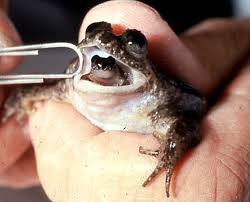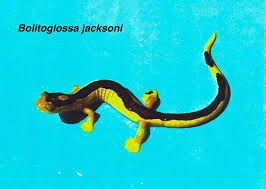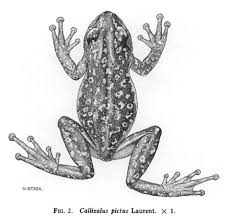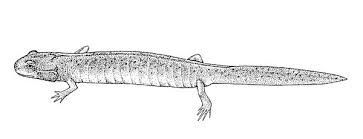Frogs are known as amphibians that can live in two worlds, namely on land and in water. Reporting from the National Geographic.com site, said there are 10 species of frogs have become extinct suspected of earth. And recently alleged that missed, there are two species that are still alive and one of them berhabitat in Indonesian Borneo. What are the 10 species of frogs, we describe the following:
10. Gold frogs

Gold frogs. This frog was last seen in Costa Rica in 1989. The frog loses
possible because of the drought and the chytrid fungus attacks. For that Conservation International and the International Union For Conservation of Nature (IUCN) conducted a study to re-discover this golden frog.
9. Gastric frog

Gastric frog. The hull frog is a frog native of Australia. Has the scientific name Rheobatrachus vitellinus. This frog is unique because the female frog will swallow the fertilized egg into the stomach and then raise the child in its mouth, so as if the frog is to bear children of her mouth. Last seen in 1985. Thought extinct due to chytrid fungus attacks.
8. Mesopotamia beaked toad

Mesopotamia beaked toad. Last seen in 1914. There has never been a documented through photographs. Suspect still alive and berhabitat isolated in Colombia, for the frog is included in income by the IUCN list.
7. Frog Bolitoglossa jacksoni

Bolitoglossa jacksoni. Frogs can climb salamander is thought to have disappeared from Guatemala and was last seen in 1975. Frogs salamanders that have a yellow complexion and black on the back. Allegedly disappeared due to an increase in agricultural land and settlements in Guatemala so as to make the area his life disappear. Current IUCN and San Carlos University, Guatemala has done a great living on the frogs salamanders.
6. Frog Callizalus Pictus laurent

Callizalus Pictus laurent. This frog has a habitat around the Congo and Rwanda. Has a body about 37 mm for males and 43 for females. Living in upland bamboo forests Itombwe. Because climate change is very drastic to make this frog disappeared, and the latter still can be seen in the 1950's.
5. Frogs Rio Pescado

Rio Pescado frog Atelopus Stubfoot or balios. Declared missing since last seen in the month of april 1995. Chytrid fungus is suspected that an animal makes it disappear from circulation. Besides the obvious degradation and loss of habitat soil life increasingly difficult for these frogs. Balios Atelopus species live along the river and lowland rain forest in southwest Ecuador. Popolasinya expected to decline by more than 80% over three generations. But in September 2010 the species was rediscovered Eduardo Toral-Contreras and Tapia Elicio.
4. Frog Hynobius turkestanicus

Hynobius turkestanicus or Turkestanian Salamander. Knowledge of this frog is very minimal. There are only two species in the year since 1909. Is likely to have habitat in Kyrgyzstan, Tajikistan or Uzbekistan. Based on information from International Conservasi This frog species has a function as a guard animal hygiene freshwater ecosystems and control germs in the water, as one possibility as a painkiller for humans.
3. scarlet frog

Sorianoi or the scarlet frog Atelopus has a light orange color in his body. Living in an isolated forest, Paramito de San Francisco, near the town Guaraque in southwestern Venezuela. Last seen in 1990.
2. Hula Painted Frog

Discoglossus nigriventer or Hula painted frog has a habitat in two areas on the East Coast Lake Huleh, Israel and possibly also in adjacent regions Syria. Status was last seen in 1955. Said to be disappearing because of habitat in lakes Huleh swamp drained in the 1950s to eradicate malaria mosquitoes and agricultural soil.
1. Rainbow frog

Borneo rainbow toad or Sambas Stream Toad, or known by the scientific name of Ansonia latidisca. Last seen in the 1950s. Habitat on the island of Borneo is Mount Damus, Kalimantan (Indonesia), and Mount Penrissen, in western Sarawak (Malaysia). This frog has a long body, such as gravel and rough-skinned colored like a rainbow between bright red, green, yellow and purple. According amphibian expert Robin Moore is poisonous frogs and has a bright color as the adjustment by posing as the surrounding colors. Search conducted by the international conservation and University Malaysia Sarawak montane forest that lies between Sarawak and West Kalimantan region. And in 2011 this frog has been rediscovered. With the discovery of the Borneo Rainbow Toad can encourage research on habitat and other inventions.
sumber
10. Gold frogs

Gold frogs. This frog was last seen in Costa Rica in 1989. The frog loses
possible because of the drought and the chytrid fungus attacks. For that Conservation International and the International Union For Conservation of Nature (IUCN) conducted a study to re-discover this golden frog.
9. Gastric frog
Gastric frog. The hull frog is a frog native of Australia. Has the scientific name Rheobatrachus vitellinus. This frog is unique because the female frog will swallow the fertilized egg into the stomach and then raise the child in its mouth, so as if the frog is to bear children of her mouth. Last seen in 1985. Thought extinct due to chytrid fungus attacks.
8. Mesopotamia beaked toad
Mesopotamia beaked toad. Last seen in 1914. There has never been a documented through photographs. Suspect still alive and berhabitat isolated in Colombia, for the frog is included in income by the IUCN list.
7. Frog Bolitoglossa jacksoni
Bolitoglossa jacksoni. Frogs can climb salamander is thought to have disappeared from Guatemala and was last seen in 1975. Frogs salamanders that have a yellow complexion and black on the back. Allegedly disappeared due to an increase in agricultural land and settlements in Guatemala so as to make the area his life disappear. Current IUCN and San Carlos University, Guatemala has done a great living on the frogs salamanders.
6. Frog Callizalus Pictus laurent
Callizalus Pictus laurent. This frog has a habitat around the Congo and Rwanda. Has a body about 37 mm for males and 43 for females. Living in upland bamboo forests Itombwe. Because climate change is very drastic to make this frog disappeared, and the latter still can be seen in the 1950's.
5. Frogs Rio Pescado
Rio Pescado frog Atelopus Stubfoot or balios. Declared missing since last seen in the month of april 1995. Chytrid fungus is suspected that an animal makes it disappear from circulation. Besides the obvious degradation and loss of habitat soil life increasingly difficult for these frogs. Balios Atelopus species live along the river and lowland rain forest in southwest Ecuador. Popolasinya expected to decline by more than 80% over three generations. But in September 2010 the species was rediscovered Eduardo Toral-Contreras and Tapia Elicio.
4. Frog Hynobius turkestanicus
Hynobius turkestanicus or Turkestanian Salamander. Knowledge of this frog is very minimal. There are only two species in the year since 1909. Is likely to have habitat in Kyrgyzstan, Tajikistan or Uzbekistan. Based on information from International Conservasi This frog species has a function as a guard animal hygiene freshwater ecosystems and control germs in the water, as one possibility as a painkiller for humans.
3. scarlet frog

Sorianoi or the scarlet frog Atelopus has a light orange color in his body. Living in an isolated forest, Paramito de San Francisco, near the town Guaraque in southwestern Venezuela. Last seen in 1990.
2. Hula Painted Frog

Discoglossus nigriventer or Hula painted frog has a habitat in two areas on the East Coast Lake Huleh, Israel and possibly also in adjacent regions Syria. Status was last seen in 1955. Said to be disappearing because of habitat in lakes Huleh swamp drained in the 1950s to eradicate malaria mosquitoes and agricultural soil.
1. Rainbow frog

Borneo rainbow toad or Sambas Stream Toad, or known by the scientific name of Ansonia latidisca. Last seen in the 1950s. Habitat on the island of Borneo is Mount Damus, Kalimantan (Indonesia), and Mount Penrissen, in western Sarawak (Malaysia). This frog has a long body, such as gravel and rough-skinned colored like a rainbow between bright red, green, yellow and purple. According amphibian expert Robin Moore is poisonous frogs and has a bright color as the adjustment by posing as the surrounding colors. Search conducted by the international conservation and University Malaysia Sarawak montane forest that lies between Sarawak and West Kalimantan region. And in 2011 this frog has been rediscovered. With the discovery of the Borneo Rainbow Toad can encourage research on habitat and other inventions.
sumber